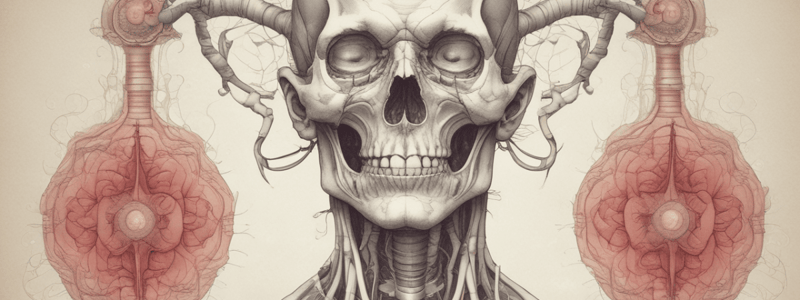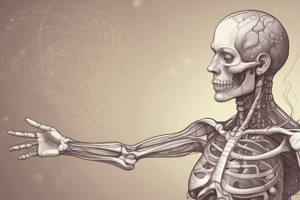Podcast
Questions and Answers
What is the location of the nasopharynx in relation to the nasal cavity?
What is the location of the nasopharynx in relation to the nasal cavity?
- Cranial (correct)
- Dorsal
- Ventral
- Caudal
Which part of the pharynx is located cranial to the larynx?
Which part of the pharynx is located cranial to the larynx?
- Oropharynx
- Nasopharynx
- Oesophagus
- Laryngopharynx (correct)
What is the location of the oropharynx in relation to the oral cavity?
What is the location of the oropharynx in relation to the oral cavity?
- Dorsal
- Ventral
- Cranial
- Caudal (correct)
Which part of the pharynx is dorsal to the soft palate?
Which part of the pharynx is dorsal to the soft palate?
What is the location of the laryngopharynx in relation to the soft palate?
What is the location of the laryngopharynx in relation to the soft palate?
Match the parts of the pharynx with their location in relation to the nasal cavity:
Match the parts of the pharynx with their location in relation to the nasal cavity:
Match the parts of the pharynx with their location in relation to the larynx:
Match the parts of the pharynx with their location in relation to the larynx:
Match the parts of the pharynx with their location in relation to the soft palate:
Match the parts of the pharynx with their location in relation to the soft palate:
Match the parts of the pharynx with their location in relation to the oral cavity:
Match the parts of the pharynx with their location in relation to the oral cavity:
Match the parts of the pharynx with their location in relation to the oesophagus:
Match the parts of the pharynx with their location in relation to the oesophagus:
What is the primary function of the larynx?
What is the primary function of the larynx?
What is the purpose of the epiglottis?
What is the purpose of the epiglottis?
What type of tissue is the larynx composed of?
What type of tissue is the larynx composed of?
What is the role of the larynx in regulating airflow?
What is the role of the larynx in regulating airflow?
What can happen to the larynx due to nervous system disorders?
What can happen to the larynx due to nervous system disorders?
What is the primary result of the larynx's function in producing vibrations?
What is the primary result of the larynx's function in producing vibrations?
What is the purpose of the epiglottis in relation to the larynx?
What is the purpose of the epiglottis in relation to the larynx?
What is the characteristic of the tissue that makes up the larynx?
What is the characteristic of the tissue that makes up the larynx?
What is the importance of the larynx in relation to airflow?
What is the importance of the larynx in relation to airflow?
What is the significance of the larynx during intubation of a patient?
What is the significance of the larynx during intubation of a patient?
The larynx also known as the ______ produces vibrations.
The larynx also known as the ______ produces vibrations.
The ______ prevents inhalation of food and foreign material during swallowing.
The ______ prevents inhalation of food and foreign material during swallowing.
The larynx is composed of ______ tissue with a mucosal lining.
The larynx is composed of ______ tissue with a mucosal lining.
The larynx plays a crucial role in controlling ______ in and out of the lungs.
The larynx plays a crucial role in controlling ______ in and out of the lungs.
The larynx can be affected by ______ control disorders, leading to paralysis.
The larynx can be affected by ______ control disorders, leading to paralysis.
What happens to the larynx during swallowing?
What happens to the larynx during swallowing?
What is the function of the soft palate during swallowing?
What is the function of the soft palate during swallowing?
What is the purpose of breathing stopping during swallowing?
What is the purpose of breathing stopping during swallowing?
Which part of the respiratory tract is responsible for gas exchange?
Which part of the respiratory tract is responsible for gas exchange?
What is the sequence of the lower respiratory tract from the trachea?
What is the sequence of the lower respiratory tract from the trachea?
What happens to the larynx during deglutition?
What happens to the larynx during deglutition?
What is the function of the soft palate during deglutition?
What is the function of the soft palate during deglutition?
What is the main reason for breathing to stop during deglutition?
What is the main reason for breathing to stop during deglutition?
Which part of the lower respiratory tract is responsible for gas exchange?
Which part of the lower respiratory tract is responsible for gas exchange?
What is the sequence of the lower respiratory tract from the trachea?
What is the sequence of the lower respiratory tract from the trachea?
During deglutition, the epiglottis uncovers the airway.
During deglutition, the epiglottis uncovers the airway.
The soft palate seals off the oral cavity during swallowing.
The soft palate seals off the oral cavity during swallowing.
The trachea is responsible for gas exchange.
The trachea is responsible for gas exchange.
The larynx is pushed caudally during deglutition.
The larynx is pushed caudally during deglutition.
Breathing continues during swallowing.
Breathing continues during swallowing.
Match the following parts of the lower respiratory tract with their description:
Match the following parts of the lower respiratory tract with their description:
Match the following events with their occurrence during deglutition:
Match the following events with their occurrence during deglutition:
Match the following parts with their function during deglutition:
Match the following parts with their function during deglutition:
Match the following structures with their location in the lower respiratory tract:
Match the following structures with their location in the lower respiratory tract:
Match the following events with their occurrence during normal respiration:
Match the following events with their occurrence during normal respiration:
What is the main function of the cilia in the trachea?
What is the main function of the cilia in the trachea?
Where does the trachea divide into two main bronchi?
Where does the trachea divide into two main bronchi?
What type of tissue lines the trachea?
What type of tissue lines the trachea?
What is the purpose of mucus secretion in the trachea?
What is the purpose of mucus secretion in the trachea?
What is the trachea commonly known as?
What is the trachea commonly known as?
The trachea is responsible for gas exchange in the respiratory system.
The trachea is responsible for gas exchange in the respiratory system.
The trachea divides into two main bronchi at the carina.
The trachea divides into two main bronchi at the carina.
The trachea is lined with epithelial tissue.
The trachea is lined with epithelial tissue.
Cilia in the trachea help to move mucus towards the lungs.
Cilia in the trachea help to move mucus towards the lungs.
The trachea is also known as the esophagus.
The trachea is also known as the esophagus.
Match the following structures in the trachea with their functions:
Match the following structures in the trachea with their functions:
Match the following characteristics with the trachea:
Match the following characteristics with the trachea:
Match the following parts of the trachea with their descriptions:
Match the following parts of the trachea with their descriptions:
Match the following events in the trachea with their purposes:
Match the following events in the trachea with their purposes:
Match the following components of the trachea with their properties:
Match the following components of the trachea with their properties:
Flashcards are hidden until you start studying
Study Notes
Pharynx Nasopharynx Caudal to the nasal cavity Cranial to the oesophagus Dorsal to the soft palate Oropharynx Caudal to the oral cavity Cranial to the laryngopharynx Ventral to the soft palate Laryngopharynx Cranial to the larynx Caudal to the soft palate Cranial to the larynx
Studying That Suits You
Use AI to generate personalized quizzes and flashcards to suit your learning preferences.




